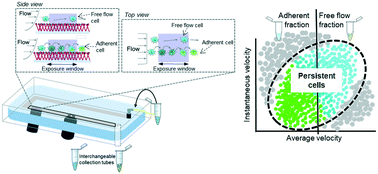Photoconversion and chromatographic microfluidic system reveals differential cellular phenotypes of adhesion velocity versus persistence in shear flow†
Abstract
An integrated photoconversion and cell sorting parallel-plate chromatography channel enabling the measurement of instantaneous and average velocities of cells mediating adhesion in flow fields was engineered to study the mechanisms underlying adhesion to selectins by metastatic cancer cells. Through the facile enrichment of cells into subfractions of differing adhesive behaviors and a fluorescent velocity probe amenable to off-chip analysis, underlying, causal molecular profiles implicated in differing adhesive phenotypes of metastatic cancer cells could be interrogated. This analytical method revealed selectin-mediated rolling adhesion to be strongly associated with expression of selectin ligands, correlations that vary with ligand type and rolling velocity magnitude. Discrete selectin ligand expression profiles were also found to underlie persistent versus non-persistent adhesion on selectins, suggestive of divergent regulatory mechanisms. This integrated cell sorting and photoconversion microfluidic platform thus enables in vitro analysis and comparisons of adhesive phenotypes as they relate to mechanisms of cancer cell metastasis in the context of selectin mediated adhesion, revealing new insights into potential cancer dissemination pathways.



 Please wait while we load your content...
Please wait while we load your content...